Features
CONCLUSION: MISSIONS OF A GLOBAL PROFESSOR : CONFESSIONS OF A GLOBAL GYPSY

Dr. Chandana (Chandi) Jayawardena DPhil

President – Chandi J. Associates Inc. Consulting, Canada
Founder & Administrator – Global Hospitality Forum
chandij@sympatico.ca
Struggling with Doctoral Studies
By 1998, I was struggling with my doctoral research. By then I realized that doing a Ph.D. in the midst of a busy hotel career, at times demanding 16-hour work days, was nearly impossible. I was thinking of a way to find the time to continue my doctoral research, but could not figure out a practical way to manage my busy schedule in order to do all the things I loved doing.
Every Wednesday, I hosted a carefully selected dozen VIPs from Jamaica for an informal cocktail reception at the General Manager’s apartment at Le Meridien Jamaica Pegasus Hotel. That type of PR with a personal touch, worked well in Jamaica. One day, an invitee for a such reception was an old friend of mine from my time in Guyana, Professor Dr. Kenneth Hall. He had been recently appointed as the Pro-Vice Chancellor of the University of West Indies (UWI), and the Principal of its main campus. Later he became the Governor General of Jamaica and was knighted by the Queen of the United Kingdom, as Sir Kenneth.
During that reception in 1998, having accidentally noticed the five books I had co-authored or edited up to that time, Professor Hall was amazed. “Chandi, I did not know that you, in addition to being a busy hotelier, also had been an academic, researcher and writer!” I casually mentioned to him about my post-secondary full-time and part-time teaching in Sri Lanka, the United Kingdom (UK), Switzerland and Guyana. He also asked questions about my time in four European countries, 16 years prior, on an UNDP/ILO Fellowship on Pedagogical Teaching and Training Methodology.
The very next day, Professor Hall sent one of UWI Deans with an excellent offer for me to join them as Senior Lecturer (Associate Professor) in Tourism Management. They offered me an excellent salary and benefit package including a four-bedroom bungalow near the main campus, and lot of free time to finish my doctoral studies in UK. I negotiated two years of sabbatical leave from Forte PLC in England, and accepted the offer from UWI.
In addition to doctoral research in England, I also enrolled for a second Ph.D. in Sustainable Tourism Development at UWI. With that, I became a full-time educator and doctoral researcher, at the first regional university of the world – UWI, which had been established by University of London, UK, as an affiliated institution in 1948. Professor Hall became my new mentor and helped me to progress rapidly in the academic world. I co-authored two significant articles on ‘Caribbean Tourism’ with Professor Hall and the Secretary General of the Caribbean Tourism Organization (CTO) – Dr. Jean Holder.
Developing the first Master’s Degree in Tourism in the Caribbean
Within three months of joining UWI, I was given an exciting additional job – to develop the first Master’s degree in Tourism & Hospitality Management in the Caribbean. It was funded by the European Union, and required me to travel around the Caribbean. I was able to do research and interview leaders of tourism in most of the 32 countries in the Caribbean. Within a year I launched the master’s degree as the founding Programme Leader/Academic Director. In addition, I also worked as the Coordinator of the Tourism Stream of their MBA Program, and the Marketing Course Coordinator for the School of Management, which had 2,000 students.
Through my new research focus, I gradually became an expert on Caribbean Tourism. In 2000, soon after I completed my doctoral studies in UK, UWI awarded me a prestigious post-doctoral research fellowship on ‘Caribbean Tourism’. After that, I resigned from Forte PLC, in spite of an attractive offer to become the General Manager of a 750 roomed Le Meridien Hotel by the Red Sea in Egypt.
To improve my teaching, I did further studies in 2000, and became a Certified Hospitality Educator (CHE) in USA. I firmly believed that, “those who dare to teach should never cease to learn.” I also spent time studying visual art at the University of Guyana, and Edna Manley College of the Visual and Performing Arts in Jamaica. Finally, I gained two qualifications in fine art and painting from George Brown College in Canada. I thoroughly enjoyed those study programs.
During my five years at UWI, I edited six books on ‘Caribbean Tourism’, while presenting regularly at Caribbean academic conferences. UWI was pleased with my contributions to the body of knowledge in Caribbean Tourism, the main industry of this most tourism-depended region in the world. I became very active in scholarly publications, with over 100 journal articles, and in 2022, I published my 23rd book in the UK.
Moving to Canada as a Professor
The academic world opened many new doors for me. In 2001, I went to Canada on an UWI-Ryerson University one-year faculty exchange special agreement, as a Visiting Professor of Ryerson University. There, apart from teaching, my key contribution was to create a research and publication culture within the university’s School of Hospitality and Tourism Management (established in 1946 as the first hotel school in Canada). I organized a couple of round tables with the tourism industry and education leaders of Canada, and focused on publishing articles and journal issues dedicated to tourism and hospitality management in Canada.
Developing ‘In-company’ Graduate Programs for Senior Managers
I also did part-time concurrent work for an amazing consortium of leading business schools around the world – International Management Centres Association (IMCA), headquartered in UK. Their non-doctoral degree granting hub was set up in Boulder, Colorado, USA. It was an early virtual university. As doctoral programs were accredited by the British Accreditation Council for Independent Further and Higher Education, those were awarded in UK.
I learned a lot about the business of higher education from IMCA, and from two of their subsidiaries – IMCA Socrates Limited in UK and the Canadian School of Management. I commenced with them in 1998 as an Associate Professor and by 2001 was promoted as a professor. In addition, by 2003, I was promoted as a Vice President of both organizations. I was responsible mainly for market development and setting up ‘in-company’ graduate programs for managers in large organizations and trade associations in the Tourism and Hotel Industry in Jamaica, Barbados, Canada etc. I also did some part-time on-line teaching for University of Surrey in UK. The icing on the cake was a few prestigious awards in recognition of my contributions.
Elected President of HCIMA, UK
From 2001, for five years I was elected, through an international vote, to the executive council of the world’s largest, professional body for hospitality managers – Hotel Catering International Management Association (HCIMA) in UK. HCIMA was also the largest accrediting body for education programs in hospitality management in the Commonwealth. The Leadership team of HCIMA was responsible for 15,000 members (Hospitality Managers) from 104 Countries. Towards the end of my five years in the executive council, we initiated a re-branding of HCIMA to the Institute of Hospitality, UK. Throughout an 85-year history, I was the only non-European to be elected as the President of HCIMA. I was also the Chairman of the company – HCIMA Ltd., UK.
Joining Ontario Community College system
In 2005, I joined the Ontario Community College system which has 24 colleges as degree granting institutions. Initially I worked as a Professor and Program Coordinator at Niagara College. As teaching at colleges is much different from teaching at universities, I completed a ‘College Educator’ training program over three summers.
During my time at Niagara College, I was released for a short period to undertake a high-level consulting assignment offered by the government of Guyana. In this assignment, my main contribution was opening the largest hotel in Guyana – Buddy’s International (today, Ramada Georgetown Princess) as the General Manager in 2007.
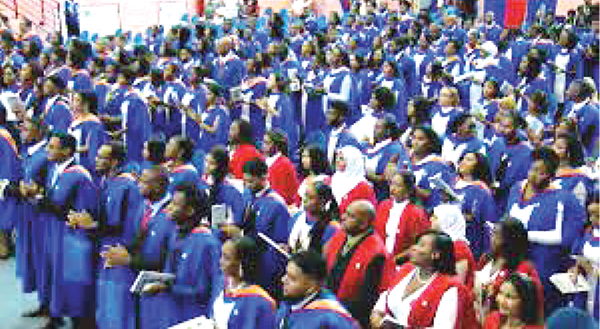
Becoming a College Dean
In 2007, I was recruited as a Dean to George Brown College in Toronto. There, for five years from 2007 to 2012, as Associate Dean, I was responsible for all academic aspects of the largest faculty of Tourism, Events, Hospitality Management and Culinary Arts in Canada. I was trained as a Dean by an experienced and highly innovative Dean – John Walker.
My responsibilities included leading three schools with three Academic Chairs, 60 full-time Professors (and 200 part-time Instructors) and an academic budget of $30 million. Within five-years we increased our student enrolments from 2,400 to 3,300 full-time students and 8,500 continuing education registrants (equivalent to another 1,700 full-time students) in our centre. At George Brown College I improved my knowledge about innovation in post-secondary education. I was responsible for applied funded research and publishing.
In addition, I also held responsibility for the centre’s enrolment plans, business plans, academic strategies, key performance indicators, student success programs, 17 program advisory committees (with over 155 industry partners), program portfolio analysis, program development, program reviews, program pathways, faculty development, and editing annual innovation reports. I was also involved in some aspects of 10 academic partnerships in China, India, Brazil, Panama, Italy and France.
Visions of a Global Citizen – Consulting
In 2012, I was recruited as the Dean for Business and Hospitality at the Vancouver Community College, British Columbia. Due to family commitments, however, we decided not to move from Ontario to British Columbia. I decided to set up my consulting firm in the same year, while spending more time with the family and on my hobbies of academic publishing and visual art. I held a large number of solo art exhibitions and took part in many group art shows.
Since 2012, my consulting firm has handled over 40 assignments. Including the consulting assignments I did prior to that, I was fortunate enough to have contracts with over 50 organizational clients. These clients included the European Union, USAID, Caribbean Tourism Organization, Amazon Corporate Treaty Organization, Government of Guyana, Sri Lanka Tourism Development Authority, Jamaica Hotel & Tourist Association, Barbados Hotel & Tourism Association, Heads of Hospitality & Tourism Ontario, Canada, Sri Lanka Institute of Tourism & Hotel Management, Forte Hotels, UK, Sandals Resorts, Jamaica, Sandy Lane Hotel, Barbados, and a few community colleges in Canada and many hotels in Sri Lanka.
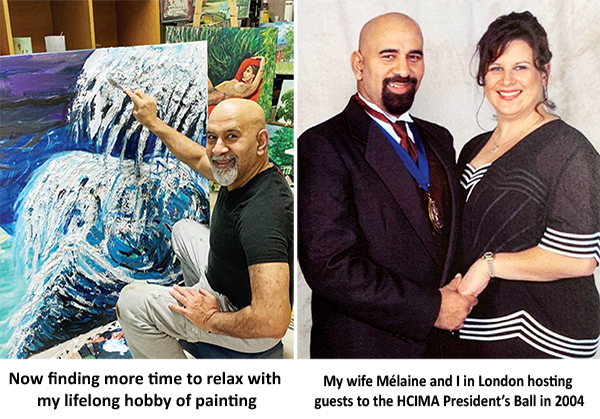
Since 2014, I have co-chaired a highly successful, annual event – The International Conference on Hospitality and Tourism Management (ICOHT). I continue to write and publish and to also serve on the editorial advisory boards for two British and South American academic journals. I also teach the masters’ degree students of the Tourism Economics and Hospitality Management program at the University of Colombo. These activities help me to keep busy and do work that will benefit many others.
Team Building Through Art and Keynoting
Some of the seminars I conducted, commenced with my new concept of ‘Team Building Through Art’. I used this as the ice-breaker, and encouraged the participants to create group art work using the talents of team members. This concept has been very popular and useful.

Mastering Bridge
I also learnt to play bridge nine years ago, and progressed rapidly in this Olympic-recognized sport. I managed to earn four North American qualifications in bridge – Certified Club Director, Accredited Bridge Teacher, Diploma in Duplicate Bridge, and Silver Life Master. I regularly run bridge courses for beginners and intermediate players. I also organize various Bridge events and act as a Tournament Chair. I direct two games a week and compete at bridge clubs three times a week. As the old saying goes: “All work and no play, makes Jack a dull boy”.
Learning, playing, winning, directing, teaching and leading in my new hobby – Bridge
Change of Life’s Purpose
From early 2020, due to the pandemic, my consulting business activities were drastically reduced. While the world was struggling to comprehend the danger of COVID-19, my wife Mélaine was rushed to the hospital. She had never been sick in her life before that. A few hours later we heard the results of the CT scan at the emergency room. The doctor who came into Mélaine’s hospital room knelt down before giving us the shockingly bad news. Mélaine had pancreatic cancer and would have a maximum of eighteen months to live. That changed my attitude about life and priorities. During the next one and half years, I realized that my new role as the key caregiver to my dear wife would be the most important job I have ever done. Everything else were dropped or placed on a back burner.
I have realized that life should not be about working in a rat race, but doing things you love. I now lead a simple life doing what I like, when I feel like doing it. These include painting, writing, poetry, coaching, teaching, cooking and playing Bridge. I re-commenced my global travels in December 2022. This year I am hoping to reach my long-time goal of visiting 100 countries. I plan to visit two more countries, to tick that item off my bucket list.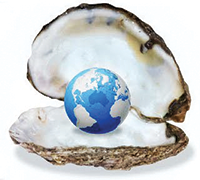
Thank You!
Last week’s 90th episode and this final 91st episode of the ‘CONFESSIONS OF A GLOBAL GYPSY’ column, provided the concluding narration. In addition, during the last 27 months, I also published nine other special feature articles on Sunday Island. I thank you for reading those 100 articles. I enjoyed sharing my personal stories with you.
“The World continues to be my Oyster…”
Features
The US-China rivalry and challenges facing the South
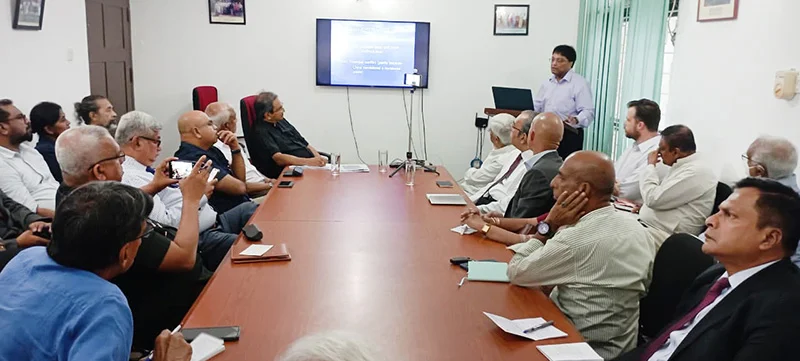
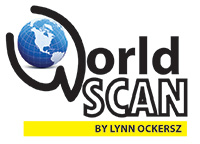 The US-China rivalry could be said to make-up the ‘stuff and substance’ of world politics today but rarely does the international politics watcher and student of the global South in particular get the opportunity of having a balanced and comprehensive evaluation of this crucial relationship. But such a balanced assessment is vitally instrumental in making sense of current world power relations.
The US-China rivalry could be said to make-up the ‘stuff and substance’ of world politics today but rarely does the international politics watcher and student of the global South in particular get the opportunity of having a balanced and comprehensive evaluation of this crucial relationship. But such a balanced assessment is vitally instrumental in making sense of current world power relations.
Thanks to the Regional Centre for Strategic Studies (RCSS), Colombo the above window of opportunity was opened on December 8th for those sections of the public zealously pursuing an understanding of current issues in global politics. The knowledge came via a forum that was conducted at the RCSS titled, ‘The US-China Rivalry and Implications for the Indo-Pacific’, where Professor Neil DeVotta of the Wake Forest University of North Carolina in the US, featured as the speaker.
A widely representative audience was present at the forum, including senior public servants, the diplomatic corps, academics, heads of civil society organizations, senior armed forces personnel and the media. The event was ably managed by the Executive Director of the RCSS, retired ambassador Ravinatha Aryasinha. Following the main presentation a lively Q&A session followed, where many a point of interest was aired and discussed.
While there is no doubt that China is fast catching up with the US with regard to particularly military, economic, scientific and technological capability, Prof. DeVotta helped to balance this standard projection of ‘China’s steady rise’ by pointing to some vital facts about China, the omission of which would amount to the observer having a somewhat uninformed perception of global political realities.
The following are some of the facts about contemporary China that were highlighted by Prof. DeVotta:
* Money is steadily moving out of China and the latter’ s economy is slowing down. In fact the country is in a ‘ Middle Income Trap’. That is, it has reached middle income status but has failed to move to upper income status since then.
* People in marked numbers are moving out of China. It is perhaps little known that some Chinese are seeking to enter the US with a view to living there. The fact is that China’s population too is on the decline.
* Although the private sector is operative in China, there has been an increase in Parastatals; that is, commercial organizations run by the state are also very much in the fore. In fact private enterprises have begun to have ruling Communist Party cells in them.
* China is at its ‘peak power’ but this fact may compel it to act ‘aggressively’ in the international sphere. For instance, it may be compelled to invade Taiwan.
* A Hard Authoritarianism could be said to characterize central power in China today, whereas the expectation in some quarters is that it would shift to a Soft Authoritarian system, as is the case in Singapore.
* China’s influence in the West is greater than it has ever been.
The speaker was equally revelatory about the US today. Just a few of these observations are:
* The US is in a ‘Unipolar Moment’. That is, it is the world’s prime power. Such positions are usually not longstanding but in the case of the US this position has been enjoyed by it for quite a while.
* China is seen by the US as a ‘Revisionist Power’ as opposed to being a ‘Status Quo Power.’ That is China is for changing the world system slowly.
* The US in its latest national security strategy is paying little attention to Soft Power as opposed to Hard Power.
* In terms of this strategy the US would not allow any single country to dominate the Asia-Pacific region.
* The overall tone of this strategy is that the US should step back and allow regional powers to play a greater role in international politics.
* The strategy also holds that the US must improve economic ties with India, but there is very little mention of China in the plan.
Given these observations on the current international situation, a matter of the foremost importance for the economically weakest countries of the South is to figure out how best they could survive materially within it. Today there is no cohesive and vibrant collective organization that could work towards the best interests of the developing world and Dr. DeVotta was more or less correct when he said that the Non-alignment Movement (NAM) has declined.
However, this columnist is of the view that rather being a spent force, NAM was allowed to die out by the South. NAM as an idea could never become extinct as long as economic and material inequalities between North and South exist. Needless to say, this situation is remaining unchanged since the eighties when NAM allowed itself to be a non-entity so to speak in world affairs.
The majority of Southern countries did not do themselves any good by uncritically embracing the ‘market economy’ as a panacea for their ills. As has been proved, this growth paradigm only aggravated the South’s development ills, except for a few states within its fold.
Considering that the US would be preferring regional powers to play a more prominent role in the international economy and given the US’ preference to be a close ally of India, the weakest of the South need to look into the possibility of tying up closely with India and giving the latter a substantive role in advocating the South’s best interests in the councils of the world.
To enable this to happen the South needs to ‘get organized’ once again. The main differences between the past and the present with regard to Southern affairs is that in the past the South had outstanding leaders, such as Jawaharlal Nehru of India, who could doughtily stand up for it. As far as this columnist could ascertain, it is the lack of exceptional leaders that in the main led to the decline of NAM and other South-centred organizations.
Accordingly, an urgent task for the South is to enable the coming into being of exceptional leaders who could work untiringly towards the realization of its just needs, such as economic equity. Meanwhile, Southern countries would do well to, indeed, follow the principles of NAM and relate cordially with all the major powers so as to realizing their best interests.
Features
Sri Lanka and Global Climate Emergency: Lessons of Cyclone Ditwah
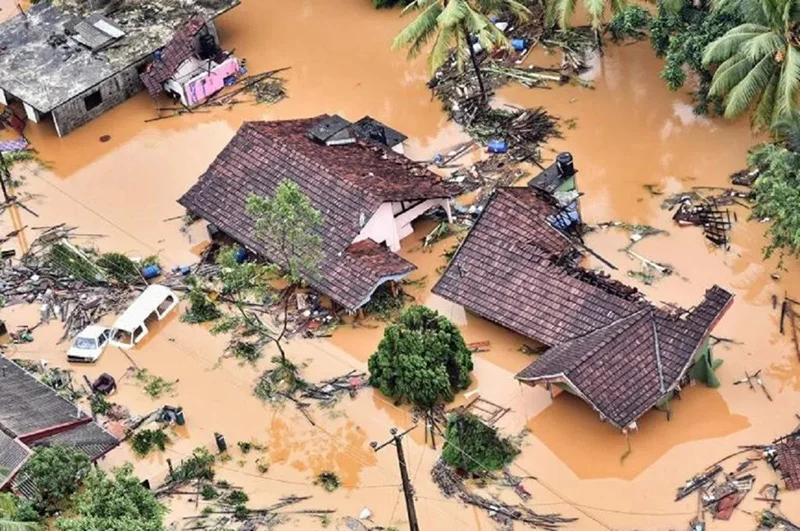
Tropical Cyclone Ditwah, which made landfall in Sri Lanka on 28 November 2025, is considered the country’s worst natural disaster since the deadly 2004 tsunami. It intensified the northeast monsoon, bringing torrential rainfall, massive flooding, and 215 severe landslides across seven districts. The cyclone left a trail of destruction, killing nearly 500 people, displacing over a million, destroying homes, roads, and railway lines, and disabling critical infrastructure including 4,000 transmission towers. Total economic losses are estimated at USD 6–7 billion—exceeding the country’s foreign reserves.
The Sri Lankan Armed Forces have led the relief efforts, aided by international partners including India and Pakistan. A Sri Lanka Air Force helicopter crashed in Wennappuwa, killing the pilot and injuring four others, while five Sri Lanka Navy personnel died in Chundikkulam in the north while widening waterways to mitigate flooding. The bravery and sacrifice of the Sri Lankan Armed Forces during this disaster—as in past disasters—continue to be held in high esteem by grateful Sri Lankans.
The Sri Lankan government, however, is facing intense criticism for its handling of Cyclone Ditwah, including failure to heed early warnings available since November 12, a slow and poorly coordinated response, and inadequate communication with the public. Systemic issues—underinvestment in disaster management, failure to activate protocols, bureaucratic neglect, and a lack of coordination among state institutions—are also blamed for avoidable deaths and destruction.
The causes of climate disasters such as Cyclone Ditwah go far beyond disaster preparedness. Faulty policymaking, mismanagement, and decades of unregulated economic development have eroded the island’s natural defenses. As climate scientist Dr. Thasun Amarasinghe notes:
“Sri Lankan wetlands—the nation’s most effective natural flood-control mechanism—have been bulldosed, filled, encroached upon, and sold. Many of these developments were approved despite warnings from environmental scientists, hydrologists, and even state institutions.”
Sri Lanka’s current vulnerabilities also stem from historical deforestation and plantation agriculture associated with colonial-era export development. Forest cover declined from 82% in 1881 to 70% in 1900, and to 54–50% by 1948, when British rule ended. It fell further to 44% in 1954 and to 16.5% by 2019.
Deforestation contributes an estimated 10–12% of global greenhouse gas emissions. Beyond removing a vital carbon sink, it damages water resources, increases runoff and erosion, and heightens flood and landslide risk. Soil-depleting monocrop agriculture further undermines traditional multi-crop systems that regenerate soil fertility, organic matter, and biodiversity.
In Sri Lanka’s Central Highlands, which were battered by Cyclone Ditwah, deforestation and unregulated construction had destabilised mountain slopes. Although high-risk zones prone to floods and landslides had long been identified, residents were not relocated, and construction and urbanisation continued unchecked.
Sri Lanka was the first country in Asia to adopt neoliberal economic policies. With the “Open Economy” reforms of 1977, a capitalist ideology equating human well-being with quantitative growth and material consumption became widespread. Development efforts were rushed, poorly supervised, and frequently approved without proper environmental assessment.
Privatisation and corporate deregulation weakened state oversight. The recent economic crisis and shrinking budgets further eroded environmental and social protections, including the maintenance of drainage networks, reservoirs, and early-warning systems. These forces have converged to make Sri Lanka a victim of a dual climate threat: gradual environmental collapse and sudden-onset disasters.
Sri Lanka: A Climate Victim
Sri Lanka’s carbon emissions remain relatively small but are rising. The impact of climate change on the island, however, is immense. Annual mean air temperature has increased significantly in recent decades (by 0.016 °C annually between 1961 and 1990). Sea-level rise has caused severe coastal erosion—0.30–0.35 meters per year—affecting nearly 55% of the shoreline. The 2004 tsunami demonstrated the extreme vulnerability of low-lying coastal plains to rising seas.
The Cyclone Ditwah catastrophe was neither wholly new nor surprising. In 2015, the Geneva-based Internal Displacement Monitoring Centre (IDMC) identified Sri Lanka as the South Asian country with the highest relative risk of disaster-related displacement: “For every million inhabitants, 15,000 are at risk of being displaced every year.”
IDMC also noted that in 2017 the country experienced seven disaster events—mainly floods and landslides—resulting in 135,000 new displacements and that Sri Lanka “is also at risk for slow-onset impacts such as soil degradation, saltwater intrusion, water scarcity, and crop failure”.
Sri Lanka ranked sixth among countries most affected by extreme weather events in 2018 (Germanwatch) and second in 2019 (Global Climate Risk Index). Given these warnings, Cyclone Ditwah should not have been a surprise. Scientists have repeatedly cautioned that warmer oceans fuel stronger cyclones and warmer air holds more moisture, leading to extreme rainfall. As the Ceylon Today editorial of December 1, 2025 also observed:
“…our monsoons are no longer predictable. Cyclones form faster, hit harder, and linger longer. Rainfall becomes erratic, intense, and destructive. This is not a coincidence; it is a pattern.”
Without urgent action, even more extreme weather events will threaten Sri Lanka’s habitability and physical survival.
A Global Crisis
Extreme weather events—droughts, wildfires, cyclones, and floods—are becoming the global norm. Up to 1.2 billion people could become “climate refugees” by 2050. Global warming is disrupting weather patterns, destabilising ecosystems, and posing severe risks to life on Earth. Indonesia and Thailand were struck by the rare and devastating Tropical Cyclone Senyar in late November 2025, occurring simultaneously with Cyclone Ditwah’s landfall in Sri Lanka.
More than 75% of global greenhouse gas emissions—and nearly 90% of carbon emissions—come from burning coal, oil, and gas, which supply about 80% of the world’s energy. Countries in the Global South, like Sri Lanka, which contribute least to greenhouse gas emissions, are among the most vulnerable to climate devastation. Yet wealthy nations and multilateral institutions, including the World Bank, continue to subsidise fossil fuel exploration and production. Global climate policymaking—including COP 30 in Belém, Brazil, in 2025—has been criticised as ineffectual and dominated by fossil fuel interests.
If the climate is not stabilised, long-term planetary forces beyond human control may be unleashed. Technology and markets are not inherently the problem; rather, the issue lies in the intentions guiding them. The techno-market worldview, which promotes the belief that well-being increases through limitless growth and consumption, has contributed to severe economic inequality and more frequent extreme weather events. The climate crisis, in turn, reflects a profound mismatch between the exponential expansion of a profit-driven global economy and the far slower evolution of human consciousness needed to uphold morality, compassion, generosity and wisdom.
Sri Lanka’s 2025–26 budget, adopted on November 14, 2025—just as Cyclone Ditwah loomed—promised subsidised land and electricity for companies establishing AI data centers in the country.
President Anura Kumara Dissanayake told Parliament: “Don’t come questioning us on why we are giving land this cheap; we have to make these sacrifices.”
Yet Sri Lanka is a highly water-stressed nation, and a growing body of international research shows that AI data centers consume massive amounts of water and electricity, contributing significantly to greenhouse gas emissions.
The failure of the narrow, competitive techno-market approach underscores the need for an ecological and collective framework capable of addressing the deeper roots of this existential crisis—both for Sri Lanka and the world.
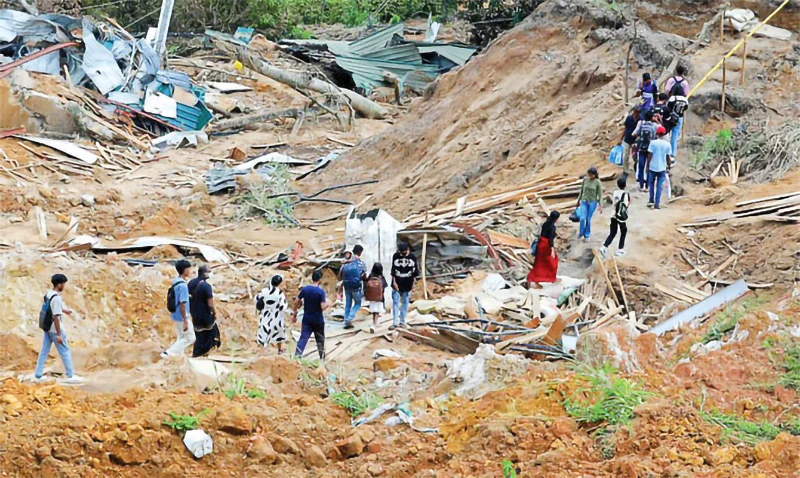
A landslide in Sri Lanka (AFP picture)
Ecological and Human Protection
Ecological consciousness demands
recognition that humanity is part of the Earth, not separate from it. Policies to address climate change must be grounded in this understanding, rather than in worldviews that prize infinite growth and technological dominance. Nature has primacy over human-created systems: the natural world does not depend on humanity, while humanity cannot survive without soil, water, air, sunlight, and the Earth’s essential life-support systems.
Although a climate victim today, Sri Lanka is also home to an ancient ecological civilization dating back to the arrival of the Buddhist monk Mahinda Thera in the 3rd century BCE. Upon meeting King Devanampiyatissa, who was out hunting in Mihintale, Mahinda Thera delivered one of the earliest recorded teachings on ecological interdependence and the duty of rulers to protect nature:
“O great King, the birds of the air and the beasts of the forest have as much right to live and move about in any part of this land as thou. The land belongs to the people and all living beings; thou art only its guardian.”
A stone inscription at Mihintale records that the king forbade the killing of animals and the destruction of trees. The Mihintale Wildlife Sanctuary is believed to be the world’s first.
Sri Lanka’s ancient dry-zone irrigation system—maintained over more than a millennium—stands as a marvel of sustainable development. Its network of interconnected reservoirs, canals, and sluices captured monsoon waters, irrigated fields, controlled floods, and even served as a defensive barrier. Floods occurred, but historical records show no disasters comparable in scale, severity, or frequency to those of today. Ancient rulers, including the legendary reservoir-builder King Parākramabāhu, and generations of rice farmers managed their environment with remarkable discipline and ecological wisdom.
The primacy of nature became especially evident when widespread power outages and the collapse of communication networks during Cyclone Ditwah forced people to rely on one another for survival. The disaster ignited spontaneous acts of compassion and solidarity across all communities—men and women, rich and poor, Buddhists, Christians, Muslims, and Hindus. Local and international efforts mobilized to rescue, shelter, feed, and emotionally support those affected. These actions demonstrated a profound human instinct for care and cooperation, often filling vacuums left by formal emergency systems.
Yet spontaneous solidarity alone is insufficient. Sri Lanka urgently needs policies on sustainable development, environmental protection, and climate resilience. These include strict, science-based regulation of construction; protection of forests and wetlands; proper maintenance of reservoirs; and climate-resilient infrastructure. Schools should teach environmental literacy that builds unity and solidarity, rather than controversial and divisive curriculum changes like the planned removal of history and introduction of contested modules on gender and sexuality.
If the IMF and international creditors—especially BlackRock, Sri Lanka’s largest sovereign bondholder, valued at USD 13 trillion—are genuinely concerned about the country’s suffering, could they not cancel at least some of Sri Lanka’s sovereign debt and support its rebuilding efforts? Addressing the climate emergency and the broader existential crisis facing Sri Lanka and the world ultimately requires an evolution in human consciousness guided by morality, compassion, generosity and wisdom. (Courtesy: IPS NEWS)
Dr Asoka Bandarage is the author of Colonialism in Sri Lanka: The Political Economy of the Kandyan Highlands, 1833-1886 (Mouton) Women, Population and Global Crisis: A Politico-Economic Analysis (Zed Books), The Separatist Conflict in Sri Lanka: Terrorism, Ethnicity, Political Economy, ( Routledge), Sustainability and Well-Being: The Middle Path to Environment, Society and the Economy (Palgrave MacMillan) Crisis in Sri Lanka and the World: Colonial and Neoliberal Origins, Ecological and Collective Alternatives (De Gruyter) and numerous other publications. She serves on the Advisory Boards of the Interfaith Moral Action on Climate and Critical Asian Studies.
Features
Cliff and Hank recreate golden era of ‘The Young Ones’
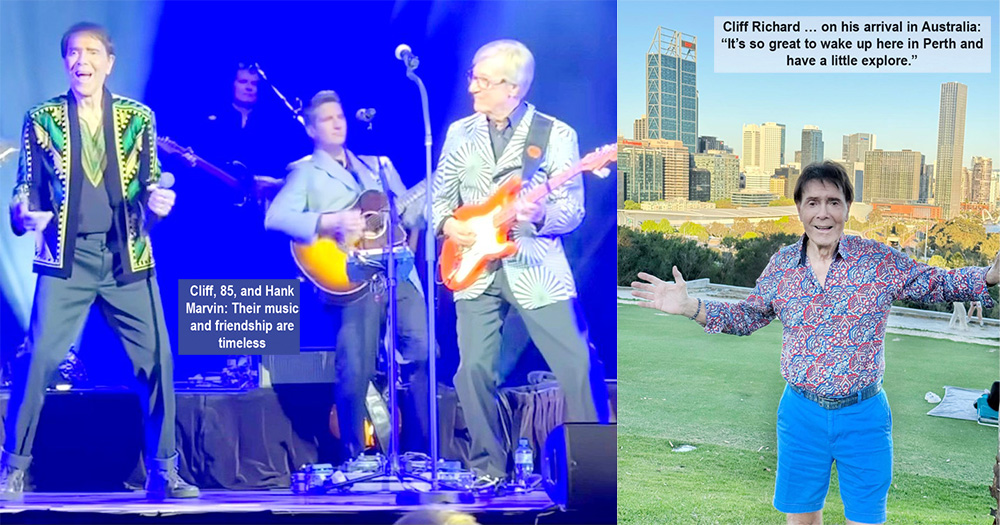
 Cliff Richard and Hank Marvin’s reunion concert at the Riverside Theatre in Perth, Australia, on 01 November, 2025, was a night to remember.
Cliff Richard and Hank Marvin’s reunion concert at the Riverside Theatre in Perth, Australia, on 01 November, 2025, was a night to remember.
The duo, who first performed together in the 1950s as part of The Shadows, brought the house down with their classic hits and effortless chemistry.
The concert, part of Cliff’s ‘Can’t Stop Me Now’ tour, featured iconic songs like ‘Summer Holiday’, ‘The Young Ones’, ‘Bachelor Boy’, ‘Living Doll’ and a powerful rendition of ‘Mistletoe and Wine.’
Cliff, 85, and Hank, with his signature red Fender Stratocaster, proved that their music and friendship are timeless.
According to reports, the moment the lights dimmed and the first chords of ‘Move It’ rang out, the crowd knew they were in for something extraordinary.
Backed by a full band, and surrounded by dazzling visuals, Cliff strode onto the stage in immaculate form – energetic and confident – and when Hank Marvin joined him mid-set, guitar in hand, the audience erupted in applause that shook the hall.
Together they launched into ‘The Young Ones’, their timeless 1961 hit which brought the crowd to its feet, with many in attendance moved to tears.
The audience was treated to a journey through time, with vintage film clips and state-of-the-art visuals adding to the nostalgic atmosphere.
Highlights of the evening included Cliff’s powerful vocals, Hank’s distinctive guitar riffs, and their playful banter on stage.
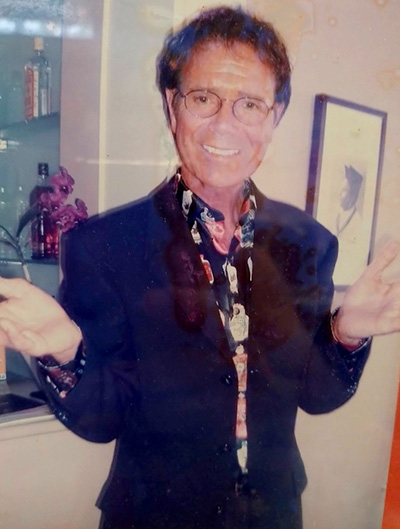
Cliff posing for The Island photographer … February,
2007
Cliff paused between songs to reflect on their shared journey saying:
“It’s been a lifetime of songs, memories, and friendship. Hank and I started this adventure when we were just boys — and look at us now, still up here making noise!”
As the final chords of ‘Congratulations’ filled the theatre, the crowd rose for a thunderous standing ovation that lasted several minutes.
Cliff waved, Hank gave a humble bow, and, together, they left the stage, arm-in-arm, to the refrain of “We’re the young ones — and we always will be.”
Reviews of the show were glowing, with fans and critics alike praising the duo’s energy, camaraderie, and enduring talent.
Overall, the Cliff Richard and Hank Marvin reunion concert was a truly special experience, celebrating the music and friendship that has captivated audiences for decades.
When Cliff Richard visited Sri Lanka, in February, 2007, I was invited to meet him, in his suite, at a hotel, in Colombo, and I presented him with my music page, which carried his story, and he was impressed.
In return, he personally autographed a souvenir for me … that was Cliff Richard, a truly wonderful human being.
-

 News3 days ago
News3 days agoOver 35,000 drug offenders nabbed in 36 days
-

 Business5 days ago
Business5 days agoLOLC Finance Factoring powers business growth
-
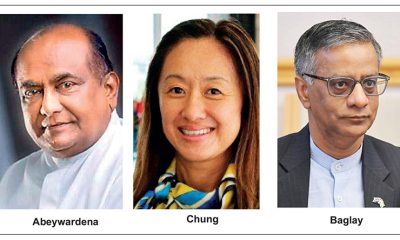
 Features1 day ago
Features1 day agoFinally, Mahinda Yapa sets the record straight
-
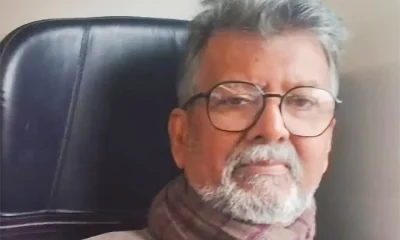
 News2 days ago
News2 days agoCyclone Ditwah leaves Sri Lanka’s biodiversity in ruins: Top scientist warns of unseen ecological disaster
-

 News5 days ago
News5 days agoCPC delegation meets JVP for talks on disaster response
-
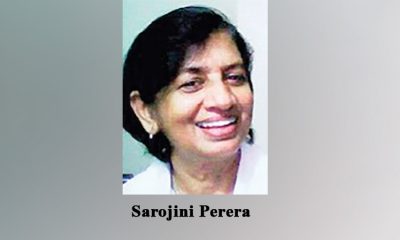
 News5 days ago
News5 days agoA 6th Year Accolade: The Eternal Opulence of My Fair Lady
-

 News3 days ago
News3 days agoRising water level in Malwathu Oya triggers alert in Thanthirimale
-

 Features4 days ago
Features4 days agoThe Catastrophic Impact of Tropical Cyclone Ditwah on Sri Lanka:













